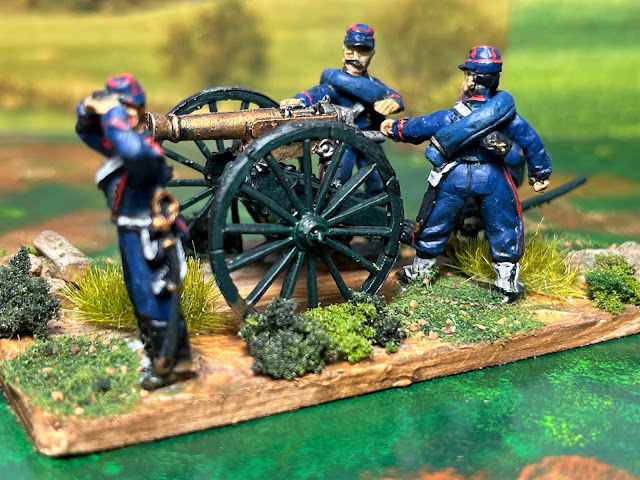Well it's back to the red pants again. This time it is the start of the Second Brigade, Second Infantry Division, 2nd Corps. The brigade consisted of the 66e and 67e Regiments and was commanded by General de Brigade Jacques Alexandre Jules Fauvart-Bastoul.
Son of a senior officer of hussars in the Grande Armée Fauvart-Bastoul was born at Béthune in 1814. He entered St Cyr in 1832 and joined the 28e Régiment three years later. He continued with that regiment until 1844, promoted through the grades to Captain. He transferred to the 7e Légère in 1853 as chef de batallion and served in Algeria. He took command of the 6e Chasseurs that same year and led them in the Crimean campaign. He was made Lt Colonel of the 14e Régiment in 1855, before transferring to the 3e Grenadier regiment in the Garde Imperiale the following year.
Made colonel in late 1857 he took command of the 36e Régiment before transferring back to the Garde in 1860 in charge of the 2e Grenadiers. Made General de brigade in 1865 he held various territorial commands until he took his brigade command in 1870.
He was engaged at Sarrbrücken, Spicheren, Rezonville and St Privat before being imprisoned after the fall of Metz. He served in the Versailles Army in the action against the Communards and was promoted to General de Division in 1871 in command of 18th Division. He retired from the army in 1879 and died at Paris in 1888 at the age of 73.
With roots tracing back to 1791 the 66e has laid claim to a host of honours in the Revolutionary and Napoleonic Wars, including action in the Vendée and the Low Countries. Part of the regiment went to the West Indies in 1802 serving in Guadeloupe, but the regiment’s real service in the Napoleonic wars was in the Peninsula, where it fought from 1807 to 1813, engaged in the actions of Vimeiro, Porto, Buçaco Fuentes de Ōnoro and Burgos, in Germany in 1813 at Lutzen, Bautzen, Leipzig and Hannau, in the 1814 Campaign at Laon, Reims Fère-Champenoise and Paris.
The regiment did not fight at Waterloo but had the dubious honour of offering the last resistance of the 100 Days episode when the Caribbean contingent stood against British forces that captured Guadeloupe in August 1815.
Recreated in 1830 the regiment served in Africa from 1832 to 1840, after which it returned to France. The third battalion had the honour of leading the procession that brought Napoleon’s remains back to France to be interred at des Invalides.
It was not engaged in the Crimea or Italy, serving instead in France then in Africa until 1867, before returning again to France.
In 1870 it served at Saarbrücken (losing 5 officers and 40 men), Spicheren (losing 12 officers and 212 men), Rezonville (where it suffered the loss of 16 officers and 575 men) and St Privat (2 officers and 27 men). It served the early part of the war under command of Colonel Charles-François Ameller, about whom I haven't been able to find much other than in 1857 he was chef de batallion in the 4e Zouaves and at that point, after 17 years of service, he had served in seven campaigns and been wounded twice.
When the regiment surrendered at Metz, the depot companies formed the 44e Régiment de Marche and fought in the Armée de l’Loire and the Armée d’Est.
After the war the regiment was back in Algeria again in 1888, but returned to France shortly after. In the Great War it served in the Marne and Verdun sectors for much of the war. After the war it was posted briefly at Constantinople before it was disbanded in 1923.
Reformed in 1939 it fought in the 18th Divsion in the battle of France.
Dissolved in June 1940 it was briefly reactivated between 1963-66.

Also completed are two more generals. These are again the Marchal Canrobert figure that ships free with three boxes of plastic figures. To get a bit of variety I have done a little Frankensteinian surgery on them. Both were decapitated and their heads were replaced by those from the plastic command sprue. At the same time I removed the right hand of each figure that was waving the troops forward and replaced them with more plastic parts - one with a hand with a pointing finger and the other one pointing with a sword. Both the hands a heads were fixed in place with pin and glue. The horse's mane was damaged when the hand and the kepi it was holding were cut away, but a bit of GreenStuff was all that was needed to repair it.

It is Labour Weekend here and it is a tradition with us to use the long weekend to get the gardens in shape and they certainly need it after the wet year we have had - in the 25 years we have lived in this house I have never seen so many weeds growing. So early this morning, while I was watching the All Blacks play the Pumas in the Rugby World Cup semi-final, three cubic metres of bark arrived and was dumped on the driveway
I am in for a long tiring day.



















































